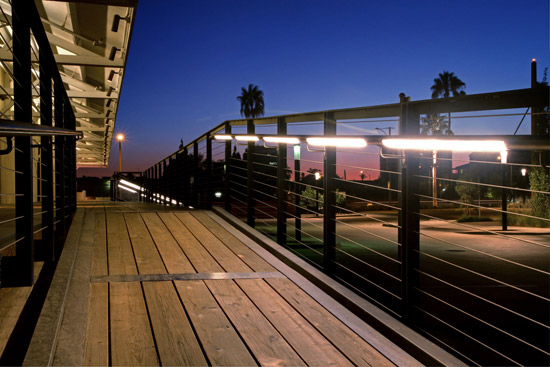Satisfying New Model Codes for Illuminating Steps, Ramps, and Paths of Egress
2009 NFPA 1, Fire Code
The 2009 NFPA 1, Fire Code addresses fire protection and life safety issues, providing requirements necessary to establish a reasonable level of fire safety and property protection. The code was developed in collaboration with fire service, fire safety, manufacturers, and insurance and building professionals.
The life safety codes in this standard have been updated to recommend that steps, ramps, and paths of egress be illuminated with a minimum of 10fc at the tread during occupancy.Specifically, the 2009 NFPA 1, Fire Code, Section 14.12.1.3 states that “during conditions of stair use, the minimum illumination for new stairs shall be at least 10 foot-candles, measured at the walking surface.”
Section 14.12.1.3, states that the floors and other walking surfaces within an exit and within the portions of the exit access and exit discharge designated in 14.12.1.1 shall be illuminated: During conditions of stair use, the minimum illumination for new stairs shall be at least 10 foot-candles (108 lux), measured at the walking surfaces. |
Pull quote of 2009 NFPA Fire Code requirement. |
At least 18 states have adopted this version of the NFPA 1, Fire Code, including: Wisconsin, Hawaii, Maryland and Delaware.
2009 NFPA 101: Life Safety Code
The 2009 NFPA 101® Life Safety Code® is the source for strategies to protect people as it relates to building construction, fire protection and occupancy. The standard includes requirements for egress, fire protection, sprinkler systems, alarms, emergency lighting, smoke barriers, and other protective measures for special hazards.
Regarding illumination requirements for stairs, section 7.8.1.3 states, “During conditions of stair use, the minimum illumination for new stairs shall be at least 10 foot-candles, measured at the walking surface.”
Regarding the emergency illumination along paths of egress, section 7.9.2.1 states that “emergency lighting facilities shall be arranged to provide initial illumination that is not less than an average of 1 foot-candle and, at any point, is not less than 0.1 foot-candle, measured along the path of egress at floor level.”
The Life Safety Code is a widely used resource. It is used, in some respect, in all fifty states in the United States and has been formally adopted by 43 state legislatures.
2009 NFPA 5000® Building Construction and Safety Code®
The NFPA 5000 code addresses building design for the safety of the occupants. Chapter 11 includes Means of Egress and section 11.8.1.3 states that “floors and other walking surfaces within an exit shall be illuminated as follows: during conditions of stair use, the minimum illumination for stairs shall be at least 10 foot-candles, measured at the walking surface.”
2003 ICC/ANSI A117.1
The ANSI standard A117.1 outlines criteria for accessibility and the 2003 edition attempted to improve the coordination between the requirements of this standard and the Fair Housing Accessibility Guidelines (FHAG) and the Americans with Disabilities Act Accessibility Guidelines (ADAAG).
Section 504.8.1, titled Illuminance Level states, “Lighting facilities shall be capable of providing ten foot-candles of illuminance, measured at the center of tread surfaces and on landing surfaces within 24 inches of the step nosing.”
In summary, recent versions of fire and life safety model codes penned by the NFPA and model codes written by ANSI recommend that stairs, ramps, and paths of egress receive a minimum level of illumination of 10 fc at the walking surface, up from the 1 fc traditionally recommended. Other model code organizations are also reassessing their requirements as it relates to illuminating steps, ramps and paths of egress and are currently reviewing proposals to increase the recommended illumination levels to 10fc at the tread, during occupancy.
Typical Designer Concerns
When designers learn of this recommendation to increase minimum illumination levels at the treads on paths of egress, stairs and ramps, there are two typical concerns that are raised.
 |
Packing House: Anaheim, California Photo courtesy of Intense Lighting |









